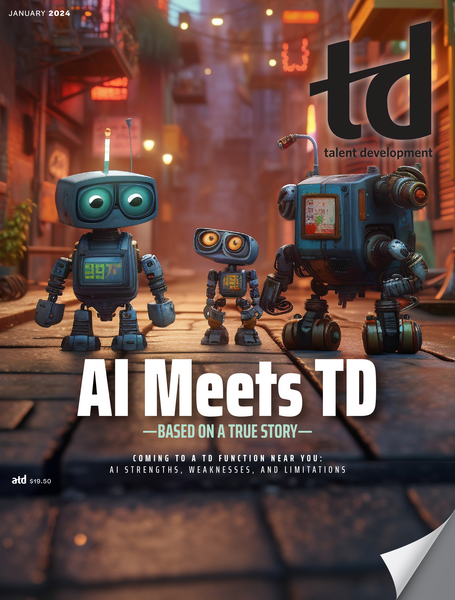TD Magazine Article
AI Meets TD
Coming to a TD function near you: AI strengths, weaknesses, and limitations
Tue Jan 02 2024

Bookmark
Coming to a TD function near you: AI strengths, weaknesses, and limitations
In a world where technology is currently evolving at breakneck speed, there's one frontier that stands out in its potential to reshape industries, businesses, and professions: artificial intelligence. Once accessible only to a niche group of technologists, new engines and tools are now democratizing AI and making it available to all. But while the promise of AI is immense, so too is the responsibility of understanding its capabilities, nuances, and limitations.
For those in talent development, AI is not just another buzzword. It is an urgent call to action. Sophisticated AI technology—generative and nongenerative in nature—is rapidly augmenting, if not replacing, the traditional tools and methodologies we once relied upon.
In this transformation, we cannot be passive observers. We must be active participants—shaping the narrative, deciphering the jargon, and bridging the gap between AI's promise and its real-world applications.
The allure of AI's apparent capabilities, from passing bar exams to excelling in the Biology Olympiad to debugging code, is undeniable. Yet, it is vital—and an ongoing task—to separate hype from reality. Our challenge is to judiciously harness AI's potential, ensuring it augments rather than replaces the human touch that is at the heart of TD.
Navigating this new and fast-moving landscape demands more than technical acumen. It requires curiosity, critical thinking, and a commitment to continuous learning.
The AI spectrum
In the contemporary technological landscape, large language models (LLMs) stand out as both marvels of engineering and subjects of intense debate. However, despite the recent excitement around that technology in particular, the term AI encompasses more than those gigantic models of computation, which have been trained on all the digitally available human text that exists. AI is a rich tapestry of continuously emerging tools—each with its unique strengths, weaknesses, and applications—separated into two broad categories: generative and nongenerative AI.
Generative AI. As their name suggests, generative models are creators. Their creation process is grounded in the vast data on which they have been trained. Drawing parallels with the human learning process, the models absorb information, process it, and then generate outputs that mirror the patterns identified in what they have previously encountered.
In TD, that can translate to tools that craft training content tailored to individual needs—more generally and long term, based on learners' previous interactions and feedback, or more short term, in the moment of need, for performance support.
As with any tool, however, there are limitations. The same model that can craft insightful content summaries can also spread misinformation; consider so-called hallucinations, which result when the LLM provides an answer that sounds good but is simply incorrect, as if the model has made it up. That emphasizes the need for conducting rigorous checks of outputs for potential mistakes.
Nongenerative AI. Often overshadowed by their generative counterparts, nongenerative models are the silent workhorses of the AI world (we used to call them machine learning). Their strength lies in analysis, pattern recognition, and decision making, working with specific, fully controllable datasets.
In the context of TD, think of tools that automatically map out learning content and resources—in line with skills frameworks or learning objectives—quickly, highly efficiently, and at scale.
A salient feature of nongenerative models is their reliance on existing data. They don't create; they optimize. They fine-tune processes, making them more efficient, streamlined, and effective.
For TD professionals who look to deploy AI tools, the key lies in creating balance. Leverage the creative prowess of generative models while grounding decisions in the analytical strengths of nongenerative ones. You must comprehend the underlying mechanics, note the potential pitfalls, and use the tools to augment—not replace—human intuition and expertise. Deploy AI tools in targeted and specific use cases, with clear outcomes and goals in mind, one step at a time.
Generative AI in the talent landscape
The transformative potential of generative AI in TD is becoming increasingly evident. The applications are vast, from automating repetitive tasks such as crafting summaries, short explanations from larger texts, flashcards for review, and multiple-choice questions for practice and end-point examination to creating fully personalized, adaptive learning experiences, including simulations.
Onboarding and training. Consider the onboarding process, which often involves a steep learning curve for new hires. Generative AI offers a unique solution in the form of chatbots that answer queries in real time, providing a more interactive and engaging onboarding experience.
AI can autogenerate training modules based on an individual's role, their existing background, and even their new personal development plan. For instance, a sales executive may receive content tailored to their specific product line, while an engineer may receive in-depth technical modules. Such personalization ensures that the content is relevant, engaging, and available for advice 24/7.
Continuous L&D. Generative AI's role doesn't end with initial training. It plays a pivotal role in continuous learning, whether improving existing skills or developing new ones. By analyzing an employee's progress, feedback, and performance metrics, AI-driven platforms can recommend new courses, workshops, or resources. The courses or workshops could be in person or hybrid. In the digital space, AI could even deliver entire courses. There are many options to choose from among the full range of training and learning modalities, each depending on the situation and the individuals involved.
Such an overall, personalized approach ensures that learning never stagnates and employees are always equipped with, or at least have easy access to, the latest knowledge and skills. Given the limitless and ever-evolving nature of data around performance and digital transformation in organizations to monitor and strategize—paired with the accelerated pace of change in the future of work from a skills perspective—having a tool that adapts to both in real time is invaluable.
Performance support. Beyond formal training, the scope of generative AI extends to performance support in the moment of need. Imagine a chatbot that offers direct advice, suggests resources, and pulls together information and processes the company has previously deployed for a similar use case or client.
While AI cannot replace the depth and nuance of human mentorship overall, it can augment the colleague who has been at the company much longer than other employees and can share critical information, ensuring that staff have constant access to such guidance and support. And in the absence of many of the spontaneous office interactions during which colleagues can answer each other's questions (informally but highly effectively), AI can provide at least a partial solution to some of the things the workforce loses in a remote working world.
The integration of generative AI isn't without challenges, however. Bias in AI models can lead to misinformation, or in certain use cases, unfair or discriminatory practices. Thus, overreliance on AI-driven content could result in a depersonalized learning environment, devoid of human touch and intuition. Quality control is yet another concern; without rigorous checks, there's a risk of propagating incorrect or outdated information.
The answer here isn't to shun AI but instead to embrace it carefully.
Navigating the complexities of AI integration
Over the years, my dialogues with senior professionals in TD, L&D, and HR, as well as senior leaders generally, have provided rich insights into the evolving dynamics of AI's role in organizations. The spectrum of opinions, hopes, and concerns paints a vivid picture of the challenges and opportunities that lie ahead.
A recurring theme in those discussions is the allure of efficiency that AI promises—one may even be tempted to use the words "silver bullet." Leaders may envision a future where departments seamlessly integrate with AI tools, with the technology automating mundane tasks, generating performance metrics in real time, and evolving training modules on the fly based on real-time feedback.
However, juxtaposed against that vision of hyperefficiency is a deep-seated reverence for the human touch. Leaders can also stress that the essence of TD, L&D, and HR lies in empathy, intuition, and genuine human connections.
Beyond such philosophical debates of ultra-long-term vision and an overly cautious approach, there's the tangible challenge of integrating AI tools into existing systems in a balanced fashion. Talent managers often share the intricacies of the process, highlighting the cultural, logistical, and technical hurdles to overcome. After all, AI tools are neither (not yet at least) plug and play nor initially aligned with an organization's specific ethos or culture, existing products, or unique clients.
Considering the potential and the pitfalls of LLMs, the journey to AI integration is multifaceted. It is not merely a technological transition; it is a cultural, ethical, and logistical transformation as well.
As AI continues to reshape the future of work, it's incumbent upon us in the TD community to stay attuned to those diverse perspectives. We must forge a path that is both innovative and grounded, ensuring that our strategies are progressive yet rooted in the timeless values that define our profession.
The necessity of continuous learning
In a time like this, marked by rapid technological advancements, the mandate for continuous learning has never been more pronounced. Especially in the realm of TD—where the tools of our trade are undergoing a seismic shift—keeping pace is a necessity.
AI's integration into TD tools is redefining the contours of our profession. AI-driven modules that offer personalized learning experiences are supplementing—and in some cases, replacing—traditional classroom training. Feedback systems are becoming more dynamic, with AI analytics offering real-time insights into learner engagement and comprehension.
To navigate such an evolving landscape, we must be proactive.
What's cutting-edge today may be obsolete tomorrow. Dedicate time to continuously learning, subscribing to AI-focused newsletters, attending webinars, participating in workshops, and joining AI-focused TD forums and communities of practice.
Moreover, collaborations with AI experts, both within and outside your company, can offer deeper understandings of how to leverage AI tools effectively. Be part of strategic conversations within your organization. Understand the broader goals and see how AI can align with them. Externally, engage with clients, partners, and peers in your community of practice. Share insights, learn from others, and build a collective understanding.
Experiment—don't shy away from trying out new AI tools. Whether it's a chatbot for learner interactions or an analytics tool to gauge training effectiveness, dive in and explore.
As we integrate more AI tools, ethical considerations come to the fore. Ensuring that AI-driven processes are transparent, unbiased, and respectful of individual privacy is paramount. Continuous learning in that context is about understanding both the latest AI tools as well as their broader societal implications.
In this age of AI, a spirit of experimentation can and will set us apart. Trying out new tools, soliciting feedback, and refining our approaches are essential. The process is dynamic and iterative, demanding both humility to acknowledge when we're wrong and the tenacity to keep refining our approach.
Embracing the future
The narrative surrounding the future of work has been a recurring theme in TD discourses. We've been immersed in discussions, debates, and deliberations about what lies ahead. But the future is no longer a distant horizon—it's here.
AI's rapid advancements are more than technological feats; they represent a paradigm shift in how we approach TD. As AI tools become an integral part of our toolkits, the onus is on us to master them, understand their nuances, and responsibly harness their potential.
The call to action is clear: Embrace AI, not as a challenge but as an opportunity to redefine TD and make learning more personalized, efficient, engaging, and effective. The future of work demands our active participation. It's time to act, innovate, and lead the way.

More from ATD

